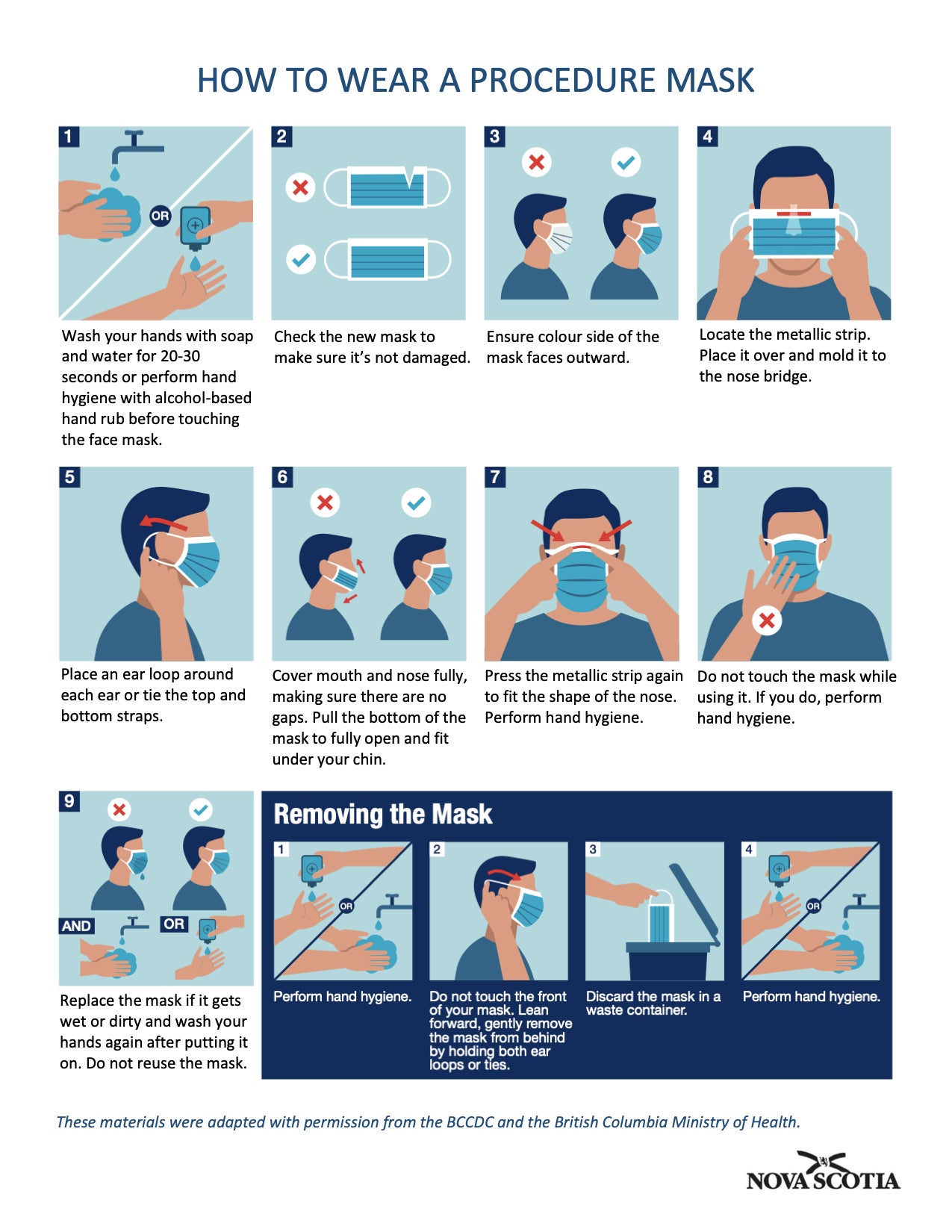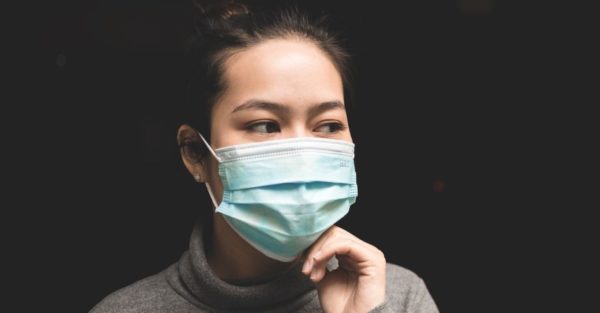CONTINUING CARE INFORMATION RELEASE
TO: Long Term Care Facilities
CC: Susan Stevens, Senior Director, Nova Scotia Health Authority Paula Langille, Director, Continuing Care, DHW
DATE: April 11, 2020
FROM:
Mary Lee, Health Association of Nova Scotia (HANS)
Vicki Elliott-Lopez, Senior Executive Director, Continuing Care, DHW
New Protocol for Masking in Long Term Care
The Department of Health and Wellness (DHW) is implementing a new protocol around masking of health care workers (HCW) in DHW-licensed long-term care during the COVID- 19 pandemic. Specifically, any staff working in or moving through resident care areas will be asked to wear a procedure mask throughout their entire shift. One (1) procedure mask per shift should be provided by facilities. An additional mask should be available if required due to soiling. Please note that paper bags (such as brown paper lunch bags) should also be available to staff for storage of masks during breaks, etc.
Facilities are expected to continue with standard processes for securing PPE supplies, conserve supplies as appropriate and have a mechanism in place to track your products. When necessary, DHW will supply procedure masks through the urgent request process established through HANS.
The attached protocol includes the following:
- Staff members who have any contact with residents should wear a procedure mask.
- Staff will wear the same procedure mask continuously for the duration of their shift,unless soiled.
- When caring for a resident with suspected or confirmed COVID-19, necessary PPE for droplet and contact precautions should be available immediately outside the resident room for easy access by staff and essential visitors (including family members). This should include gloves, long-sleeved gown, procedure/surgical mask, and eye/face protection.The attached protocol must be implemented as soon as you have adequate supply.

Long Term Care Healthcare Worker Masking Guidelines during COVID-19 Pandemic – Frequently Asked Questions (FAQ)
April 11, 2020
The Nova Scotia Department of Health and Wellness (DHW) is recommending a new practice around masking of health care workers (HCW) working in the long term care sector during the COVID-19 pandemic. These guidelines apply to public and private facilities including DHW- licensed nursing homes and residential care facilities, in addition to privately-owned and operated assisted living facilities, retirement homes, memory care homes, and enriched care homes.
Any staff working in or moving through resident care areas will be required to wear a procedure mask throughout their entire shift. One (1) procedure mask per shift will be distributed by the Administrator/Director of Care/Nurse Manager to the HCW. Additional masks will be available if required due to soiling.
For information regarding the distribution/collection of masks at the start of your shift, please contact your manager or designate.
1. Who should wear masks?
- Any HCWs who have any face-to-face (direct) or indirect contact with residents in a resident care area should wear a mask. If you are uncertain if you are included in this definition, please contact your manager.o Note: Masks should only be worn on days when working in a resident care area.
- Staff members who do not work in resident areas and are not involved with resident- facing tasks do not require masks.
2. Why are we being asked to wear the same mask throughout the day?
- Several other provinces have seen a rapid increase in the prevalence of COVID-19 in their communities, leading to outbreaks at long-term care homes. As we begin to see increasing community spread in Nova Scotia, we want to be ahead of this situation.
- Some staff have been coming to work with mild symptoms, which they do not necessarily perceive to be an infection, or are coming to work while they are well and then later developing mild upper respiratory tract infection symptoms while on duty. This poses a safety risk to both residents and other staff, and can result in exposures within the facility.
- We are taking this increased measure to ensure the continued safety of both staff and residents.
- Given the expected challenges for facilities in maintaining supply of PPE, extended use of masks – if used properly – may conserve the supply of needed procedure masks while enhancing the safety of residents and HCWs.
- If your mask becomes soiled or wet (including due to perspiration) throughout your shift, your manager will have a supply of additional masks for you.
3. We have been asked to wear a mask at all times during our shift. When can I remove the mask?
- The mask should be removed whenever a staff member is taking a break, eating a meal, or using the restroom. Social distancing (i.e., maintaining a distance of two (2) metres for residents and other staff) MUST be maintained at all times when not wearing a mask.
4. When I need to remove my mask, how do I remove is safely?
- When you need to remove your mask for a break, meal, or restroom break, please do the following:
- Take a clean, dry paper bag and write your name on it. This is important to make sure the mask can be clearly identified as yours.
- Remove the mask using the ear loops and fold the mask lengthwise from top to bottom, with the front (i.e., resident-facing) side in and the side that will be against your face out (see video)
Store your mask in a safe place in a clean, dry paper bag labeled with your name. Note: This bag should be discarded after each use.
-
- A personal locker – if readily available – can be used to store the mask in the locker with a hook. Pay close attention not to contaminate the mask in this space.
- Meticulous hand hygiene should occur before and after removing your mask and before putting the mask back on your face.
5. When is it appropriate to DISCARD my mask and use a new one?
- If your mask gets soiled during the course of your shift, you can request an additional mask as needed. Your mask should be discarded and replaced when:
- it is visibly soiled
- it makes direct contact with a resident
- it becomes so moist/humid that its integrity is affected (this includes perspiration)
6. How can I tell if my mask is soiled and should be discarded?
- Discard your mask if:
- the mask is directly exposed to respiratory droplets (through saliva/cough/sneeze)
- you touch the mask accidently with visibly soiled hands
- your mask is soaked with perspiration
Note: If the mask is covered with a face shield that was properly placed to completely cover your face, the mask is protected from these droplets.
7. How often should I discard and replace the paper bag in which I’m storing my mask?
- The paper bag should be discarded after each use.
8. What if I get a mask that doesn’t fit properly?
- It’s important that your mask fits you properly so that it doesn’t fall off. This is what ensure the protection of residents, other staff, and yourself. Please talk to your supervisor if you’ve been given a mask that does not fit properly.
9. Why are we not giving masks to residents?
- Residents who are suspected or confirmed to have COVID-19 are put on droplet and contact precautions.
- Given the potential for PPE shortage, we have elected not to provide residents with masks for source control unless they are out of their rooms.
10. Can I bring my OWN procedure masks?
- No. At this time, DHW does not support personnel bringing in their own supply of masks. Procedure masks purchased for LT facilities are controlled for quality and we cannot be sure that masks coming from elsewhere meet our quality standards.
11. Can health care workers wear homemade masks at work?
- No. Health care workers are advised to wear surgical masks, as we cannot validate the efficacy of homemade masks in preventing the spread of infection.
12. What if I need to be present during an aerosol-generating medical procedure (AGMP) with a resident who has been identified as a suspect or confirmed COVID-19 case?
- Perform hand hygiene and remove your procedure mask (place in dedicated bag/storage area – see FAQ #4 above).
- Don a fit-tested N95 Respirator and whichever PPE is required based on additional precautions posted outside the room. Read resident room signage carefully, as proper PPE for a resident may also include gloves/gown/face shield.
- Upon leaving the room, doff PPE appropriately. After performing hand hygiene, re-don your procedure mask.
13. What do I do if I walk into a droplet precautions room?
- Don eye protection (i.e., eye goggles, face shield)
- If a face shield is used, the procedure mask can continue to be used as the face shield acts as a barrier preventing the mask from being exposed to respiratory droplets.
- If eye goggles are used, the procedure mask you are wearing will need to be discarded and a clean one put on. You will need to ensure you have a clean mask available outside the resident’s room so that you can don the new mask immediately after the contaminated mask is removed prior to existing the droplet precautions room.
- Disposable face shields are to be discarded after each use; reusable face shields are to be cleaned and disinfected after each use. As the situation evolves, the reuse of disposable face shields will be re-evaluated and will be communicated to staff if instructions change. o When exiting the room, doff PPE in prescribed
order (gloves, gown, hand hygiene, eye protection, mask, hand hygiene). Do not forget to disinfect goggles or the reusable face shields if they have been used. - Don your assigned procedure mask after performing hand hygiene.
14. How else can I protect myself?
- Clean your hands before and after touching the mask for any reason.
- Avoid touching the mask unless necessary for donning/doffing and, if required, only do so by the straps.
- Ensure you are wearing the procedure mask appropriately. Masks should:
- fully cover your mouth and nose
- be pulled down to cover your chin
- be fitted to your nose. Press down to mold the metallic strip over the bridge of your nose
- Do not partially
emove the mask by pulling it down under your chin. The mask is either fully on, or fully off. Do not hang the mask around your neck or from your ear. - Clean your hands before and after contact with every resident.
- Do NOT come to work when ill. Contact your facility administrator as soon as possible if you do become ill.
15. Some residents still have essential visitors entering the facility. Do they need to wear a mask?
- Yes, essential visitors should wear a mask for their entire visit in the facility. Prior to entering a resident area, essential visitors should be instructed on how to don and doff their mask safely. Proper hand hygiene must also be enforced.
16. What else do I need to think about?
- Do NOT attempt to sanitize/clean the procedure mask.
If you have discarded your allocated mask, report to the unit where you acquired your mask at the beginning of the shift to request a new one.
Adapted from Healthcare Worker Masking Guidelines during COVID-19 Pandemic Frequently 4 Asked Questions, Nova Scotia Health Authority, April 2020

